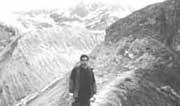
Dimdima
Online Children's Magazine from India

Dimdima
Online Children's Magazine from India

By Krishna Rao

The Std. XII
exams were over. My friend Vinayak told me that he was going with a group of 15 trekkers to the Pindari Glacier in Uttar Pradesh. Trekking to the Himalayas! Wow! I decided to join them. All the arrangements for the trek were made through the Kumaon Mandal Vikas Nigam (K.M.V.N.), a U.P. mountaineering organization.
On 9th May, we reached Delhi and after an overnight halt at Haldwani, we went to our base camp at Bhageshwar, where I had my first taste of sweet, crystal clear water directly from a spring.
Our guide asked us to pack only 3 shirts/T-shirts, 2 pants, woollens, goggles, cold creams and sunscreen lotions and leave the rest of our baggage behind.
All of us bought barsatis - locally made raincoats, which were rectangular plastic sheets folded and stitched at one end.
We began our 3-hour trek to Loharkhet at half past six in the morning. Our guide warned us not to pluck flowers or disturb nature in any way. "Don't play with nature. Remember, her mildest punishment is death."
The following morning we left for Dhakuri, where I had my first glimpse of the great Himalayas. We woke up around 4 in the morning. It was still dark. Then all of a sudden we saw the golden rays of the sun fall on a snow-clad peak. We watched transfixed, as a wide range of the Himalayas unfolded before our eyes. It was a sight none of us will ever forget.
The stretch from Khati (8km from Dhakuri) to Dwali was beautiful. There was the river Pindar flowing on one side and dense forests and mini-water falls, with pools of crystal-clear water on the other. At many places the path was hardly two feet wide. We were told that the area was prone to landslides and to keep one ear open for any rumbling sounds and the other for the sound of our guide's whistle warning us of imminent danger. At the same time we were to look out for loose soil at the edge of the path.
One of our most exciting, though scary adventures was crossing a bamboo bridge, barely an inch above the icy swift-flowing whitewaters of the Pindar river. The bridge was extremely narrow, only one person could cross it at a time. It swayed precariously with the wind and every time one of us stepped on it.
We could only go up to Pindari Zero Point, two kilometres from the actual glacier. Trekkers are not allowed beyond Zero Point. While some of us were content to just stand and admire its breathtaking view, many others played baseball using iceballs or slid down the snow-covered mountain slopes.
The trek to the glacier had been strenuous, but we never felt exhausted — ever, and except for a few who suffered from minor blisters and muscular cramps, the rest of us returned feeling rejuvenated. There were many things that we learnt : to have a good grip over our emotions — not to be moody or get irritated as it affects the mood of the entire group; to persevere, even when dog-tired ; to learn to survive, when conditions are rough; and, most of all, not to fuss over food — we ate potatoes practically at every meal, and occasionally vegetables made from oak leaves and lengda, a type of mountain fern.
Trekking is good fun and I think everyone should experience it. I for one, plan to go as often as possible—and if luck permits, I'd love to go trekking to Kailash-Mansarovar!
Last updated on :7/8/2003
EXPLORE MORE...
COMMENT ON THIS ARTICLE
Wants to share something related to this article? Please use the form below.
Dimdima is the Sanskrit word for ‘drumbeat’. In olden days, victory in battle was heralded by the beat of drums or any important news to be conveyed to the people used to be accompanied with drumbeats.
Bharatiya Vidya Bhavan
K. M Munshi Marg,
Chowpatty, Mumbai - 400 007
email : editor@dimdima.com
Bharatiya Vidya Bhavan
505, Sane Guruji Marg,
Tardeo, Mumbai - 400 034
email : promo@dimdima.com
Dimdima.com, the Children's Website of Bharatiya Vidya Bhavan launched in 2000 and came out with a Printed version of Dimdima Magazine in 2004. At present the Printed Version have more than 35,000 subscribers from India and Abroad.